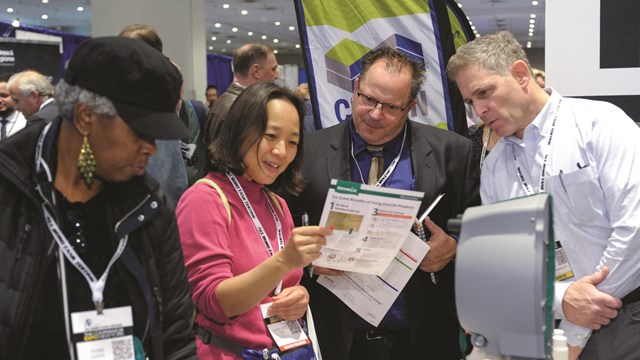Condos, co-ops and HOAs draw prospective residents with a wide variety of appealing features, from proximity to an office or family member to amazing views, to the concept of having someone else mow the lawn, fix the roof, and maintain the property. For certain residents, however, the biggest appeal of co-op or condo living is the community of neighbors and various common spaces on the property.
“In a condo, you really don’t get a chance to interact with your neighbors,” says Marc Kotler, a senior vice president in the new development group at FirstService Residential, a property management company that oversees properties in more than 20 Northeast states, including two office locations in Chicago. “These spaces build a sense of community and get them involved in the building. The apathy is huge…you can’t get people to run for a board, but if you build a sense of community, that might change.”
Popular Spaces
Looking back, Kotler has been in the multifamily industry since 1987, and understands how common spaces have changed over time. “Back then, common spaces were only about laundry rooms and larger storage spaces,” he says. “Today, buildings have common areas that are for grilling, golf simulators, dog wash areas, and wine cellars. Now, they really are demographic and user-specific areas.”
In his experience, these spaces are popular among residents. “Especially in one building—where the units are typically smaller spaces—the residents will use the common areas as a form of a living room,” Kotler says. “There are long conference tables in the rooms, and the residents will bring their laptops and work from there. You’ll also see a population of children watching television with their mothers and nannies.”
“There are many types of popular common areas in Chicago,” says Peter Santangelo, CMCA and president of Community Advantage Management, based in Chicago. “In your cities, they have their rooftops where they can suntan and barbeque, and you’ll find many pools there too. In the suburbs, pools are popular common areas and party rooms; the party rooms are used for birthday parties or bridal showers. Very rarely do I see common areas or spaces not being utilized in one way or another.”
“In terms of common areas, gyms are very important today. They are far more important than they were ten years ago,” adds Jim Stoller, president of The Building Group, also based in Chicago. “Gyms can no longer be a little space with a couple of weights and a few barbells. People in luxury buildings expect to have fully equipped, up-to-date work out rooms with free weights, mirrors, and good ventilation, which is a very important issue right now in the Chicago area. In a lot of cases, people bring in their own trainer, so the gym has to be large enough to do a full workout. If a building doesn’t have a gym, the first question is usually ‘when are they going to put one in?’”
Utilizing your Amenities
However, the line "If you build it, they will come" may have worked for Kevin Costner's character in the movie Field of Dreams, but the same doesn't always hold true for condos and HOAs. Simply having a common space for residents to use -- whether it be a hot tub, a wine cellar, or a barren conference room -- doesn’t magically entice them to leave their units and gather together. Making your common spaces into true community magnets often requires some effort.
Technically, boards are not under any obligations to do anything with common areas, but many buildings have created screening rooms, wine storage areas, and play areas for children. Fitness centers are still popular common spaces, but now rooms are more for multi-use and come with a lounge, dining room, and large screen TVs.
With a little creativity, the common spaces can bring residents together, but how these spaces are actually utilized depends on the individual community. Boards and building developers have to get very inventive when it comes to giving their residents spaces where they can spend time with family and friends or get to know their neighbors.
“I see a lot of pools and outdoor areas with barbeques and decks,” says Stoller. “But what we are seeing is that—especially among young people—they are looking for amenity-rich buildings. If something is not current, or there isn’t ample enough common areas, it is perceived as old and outdated, and that decreases value. People are looking for more than a beautiful unit these days.”
Don’t Push too Hard
How should communities address social programming and use their spaces without forcing the issue or making residents feel obligated?
The first step is to convene a committee to assess the community's spaces and determine how they're being used—or not used. Kotler says the best way to generate resident interest in the common rooms is to schedule regular programming. “You can bring in a local vendor to do a wine tasting one month, and then have a local restaurant do a cooking demonstration,” he says. “In most cases, these programs are free and build that sense of community.”
A simple Internet search can provide a lot of other programming ideas for events, from psychic readings to performances by comedians and piano recitals to book readings by professional authors.
“I can’t stress the importance of ventilation enough in common areas,” says Stoller. “If you go into these rooms and they are dank and not properly ventilated, it’s a huge turn-off. In our better buildings, we have computer areas or business areas where people can get away to if they work from home…which is happening more and more.”
Also, there are companies—such as Well Beyond 55—that can assist the board in providing unique programming to the residents. The company provides free lectures on health and legal topics, but not allowed to solicit residents.
Addressing the Bottom Line
Keeping up with the Joneses, or—in this case—where the Joneses live¸ isn’t just about showing off the building’s latest (and maybe greatest) common spaces to the residents, hoping they will come and use it to meet their neighbors. In fact, the common spaces can actually improve a building’s bottom line.
While many programs are free, other programs require admission fees, which can generate revenue. Also, a successful common area often gets residents talking about how much they enjoy the building. Word-of-mouth generates interest from other potential buyers who want to enjoy the same amenities.
“A community room should have an up-to-date kitchen with cooking facilities and wash rooms,” says Stoller. “They should also be well-maintained and it shouldn’t look like people just donated it when they moved out. It should be accessible. You shouldn’t have to go through a back area to get to; it should be someplace people are proud to entertain in.”
Even buildings with the biggest, flashiest, and fanciest common rooms and programming sometimes struggle with getting residents away from their computers, televisions, and couches. While it’s not required, a building with a sense of community can turn a simple building into a home where residents tell others how much they love living there.
Amenities Build Community
Not every building needs a separate common space to create a strong sense of community. “At one building I know that was built 15 years ago…it doesn’t have any designed common spaces for residents to throw parties or gather for events, but that doesn’t stop them from making fun things happen,” says Kotler. “Every year, they use the lobby to host a Halloween party. It’s the event that is most looked forward to by everyone, all year long, and it’s the one time a year where residents get together on a social basis and meet.”
“The bottom line is…common areas are more important today than they were 10 years ago,” says Stoller. “The market is expecting well-equipped, well-maintained facilities in their buildings. Most of the modern apartments have been built in the last 10 years and have incredible facilities, and today’s condo purchaser expects that. It can be hard for someone who has lived in a condo for 30 years to understand that they are competing in a constantly changing marketplace and they have to adapt, and that means more luxurious common areas, or they can become a dinosaur.”
Lisa Iannucci is a freelance writer and a frequent contributor to The Chicagoland Cooperator. Staff writer Christy Smith-Sloman contributed to this article.





Leave a Comment